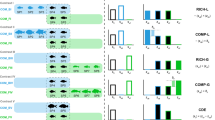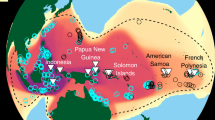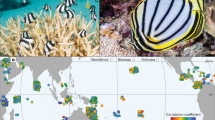Abstract
A formidable many-body problem in ecology is to understand the complex of factors controlling patterns of relative species abundance (RSA) in communities of interacting species. Unlike many problems in physics, the nature of the interactions in ecological communities is not completely known. Although most contemporary theories in ecology start with the basic premise that species interact, here we show that a theory in which all interspecific interactions are turned off leads to analytical results that are in agreement with RSA data from tropical forests and coral reefs. The assumption of non-interacting species leads to a sampling theory for the RSA that yields a simple approximation at large scales to the exact theory. Our results show that one can make significant theoretical progress in ecology by assuming that the effective interactions among species are weak in the stationary states in species-rich communities such as tropical forests and coral reefs.
This is a preview of subscription content, access via your institution
Access options
Subscribe to this journal
Receive 51 print issues and online access
$199.00 per year
only $3.90 per issue
Buy this article
- Purchase on Springer Link
- Instant access to full article PDF
Prices may be subject to local taxes which are calculated during checkout





Similar content being viewed by others
References
Hubbell, S. P. The Unified Neutral Theory of Biodiversity and Biogeography (Princeton Univ. Press, Princeton, 2001)
Volkov, I., Banavar, J. R., Hubbell, S. P. & Maritan, A. Neutral theory and relative species abundance in ecology. Nature 424, 1035–1037 (2003)
Volkov, I., Banavar, J. R., He, F., Hubbell, S. P. & Maritan, A. Density and frequency dependence explains tree species abundance and diversity in tropical forests. Nature 438, 658–661 (2005)
Latimer, A. M., Silander, J. A. & Cowling, R. M. Neutral ecological theory reveals isolation and rapid speciation in a biodiversity hot spot. Science 309, 1722–1725 (2005)
Etienne, R. S., Latimer, A. M., Silander, J. A. & Cowling, R. M. Comment on “Neutral ecological theory reveals isolation and rapid speciation in a biodiversity hot spot”. Science 311, 610 (2006)
Connolly, S. R., Hughes, T. P., Bellwood, D. R. & Karlson, R. H. Community structure of corals and reef fishes at multiple scales. Science 309, 1363–1365 (2005)
Dornelas, M., Connolly, S. R. & Hughes, T. P. Coral reef diversity refutes the neutral theory of biodiversity. Nature 440, 80–82 (2006)
Alonso, D. & Pascual, M. Comment on “A keystone mutualism drives pattern in a power function”. Science 313, 1739 (2006)
Etienne, R. S., Alonso, D. & McKane, A. J. The zero-sum assumption in neutral biodiversity theory. J. Theor. Biol. 248, 522–536 (2007)
Alonso, D. & McKane, A. J. Sampling Hubbell’s neutral theory of biodiversity. Ecol. Lett. 7, 901–910 (2004)
Etienne, R. S. & Olff, H. A novel genealogical approach to neutral biodiversity theory. Ecol. Lett. 7, 170–175 (2004)
Etienne, R. S. A new sampling formula for neutral biodiversity. Ecol. Lett. 8, 253–260 (2005)
Etienne, R. S. & Alonso, D. A dispersal-limited sampling theory for species and alleles. Ecol. Lett. 8, 1147–1156 (2005); erratum. 9, 500 (2006)
Etienne, R. S. & Alonso, D. Neutral community theory: how stochasticity and dispersal-limitation can explain species coexistence. J. Stat. Phys. 128, 485–510 (2006)
Courchamp, F., Clutton-Brock, T. & Grenfell, B. Inverse density dependence and the Allee effect. Trends Ecol. Evol. 14, 405–410 (1999)
Harte, J. Tail of death and resurrection. Nature 424, 1006–1007 (2003)
Maxwell, J. C. The Scientific Papers of James Clerk Maxwell Vol. 1 (Dover, New York, 2003)
van der Waals, J. D. On the Continuity of the Gaseous and Liquid States (Dover, New York, 2004)
Rannala, B. The sampling theory of neutral alleles in an island population of fluctuating size. Theor. Popul. Biol. 50, 91–104 (1996)
Press, W. H., Flannery, B. P., Teukolsky, S. A. & Vetterling, W. T. Numerical Recipes in C: The Art of Scientific Computing (Cambridge Univ. Press, Cambridge, 1993)
Feller, W. An Introduction to Probability Theory and Its Applications Vol. 1 (Wiley & Sons, Hoboken, 1968)
Van Kampen, N. G. Stochastic Processes in Physics and Chemistry (North-Holland, Amsterdam, 2001)
Kendall, D. G. Stochastic processes and population growth. J. Roy. Statist. Soc. B 11, 230–282 (1949)
Mosimann, J. E. On the compound multinomial distribution, the multivariate distribution, and correlations among proportions. Biometrika 49, 65–82 (1962)
Fisher, R. A., Corbet, A. S. & Williams, C. B. The relation between the number of species and the number of individuals in a random sample of an animal population. J. Anim. Ecol. 12, 42–58 (1943)
Rao, C. R. Statistical Ecology Vol. 1, Spatial Patterns and Statistical Distributions 131–142 (Penn. State Univ. Press, University Park, Pennsylvania, 1971)
Pielou, E. C. An Introduction to Mathematical Ecology (Wiley, New York, 1969)
Bulmer, M. G. On fitting the Poisson lognormal distribution to species-abundance data. Biometrics 30, 101–110 (1974)
Dewdney, A. K. A general theory of the sampling process with applications to the veil line. Theor. Popul. Biol. 54, 294–302 (1998)
Acknowledgements
We thank D. Alonso for bringing some key references to our attention and for spending an enormous amount of time in helping improve our paper. We thank D. Thomas, G. Chuyong and D. Kenfack for the data from Korup National Park, Cameroon; R. Valencia, R. Foster and R. Condit for the data from Yasuni Natinal Park, Ecuador; S. Davies, S. Tan, J. LaFrankie and P. Ashton for the data from Lambir Hills National Park, Sarawak; N. Supardi, P. Ashton and J. LaFrankie for the data from Pasoh Forest Reserve, Peninsular Malaysia; and Hubbell’s collaborators on the Barro Colorado Island plot, R. Foster and R. Condit. We also thank S. Davies for directing and coordinating the global programs of the Center for Tropical Forest Science (CTFS), which manages the plots, S. Loo for data management, and I. Rubinoff, Director of the Smithsonian Tropical Research Institute, the host institution of CTFS. The fieldwork has also received long-term support from the John D. and Catherine T. MacArthur Foundation, the Mellon Foundation, Earthwatch, Frank Levinson and the Celera Foundation, and other private foundations and individual donors. We thank S. Connolly, M. Dornelas and T. Hughes for sending us the coral-reef data. This work was supported by COFIN 2005 and by the NSF.
Author information
Authors and Affiliations
Corresponding authors
Ethics declarations
Competing interests
The authors declare no competing financial interests.
Supplementary information
Supplementary Equations
The file contains Supplementary Equations which show derivation of Eq.(2) for the joint RSA of two local communities comprising the metacommunity. (PDF 87 kb)
Rights and permissions
About this article
Cite this article
Volkov, I., Banavar, J., Hubbell, S. et al. Patterns of relative species abundance in rainforests and coral reefs. Nature 450, 45–49 (2007). https://doi.org/10.1038/nature06197
Received:
Accepted:
Issue Date:
DOI: https://doi.org/10.1038/nature06197
This article is cited by
-
Unveiling the transition from niche to dispersal assembly in ecology
Nature (2023)
-
Inter-annual variability patterns of reef cryptobiota in the central Red Sea across a shelf gradient
Scientific Reports (2022)
-
Data synthesis and dynamic visualization converge into a comprehensive biotic interaction network: a case study of the urban and rural areas of Bogotá D.C.
Urban Ecosystems (2022)
-
Invasiveness of a Growth-Migration System in a Two-dimensional Percolation cluster: A Stochastic Mathematical Approach
Bulletin of Mathematical Biology (2022)
-
Examining the generality of the biphasic transition from niche-structured to immigration-structured communities
Theoretical Ecology (2022)
Comments
By submitting a comment you agree to abide by our Terms and Community Guidelines. If you find something abusive or that does not comply with our terms or guidelines please flag it as inappropriate.



